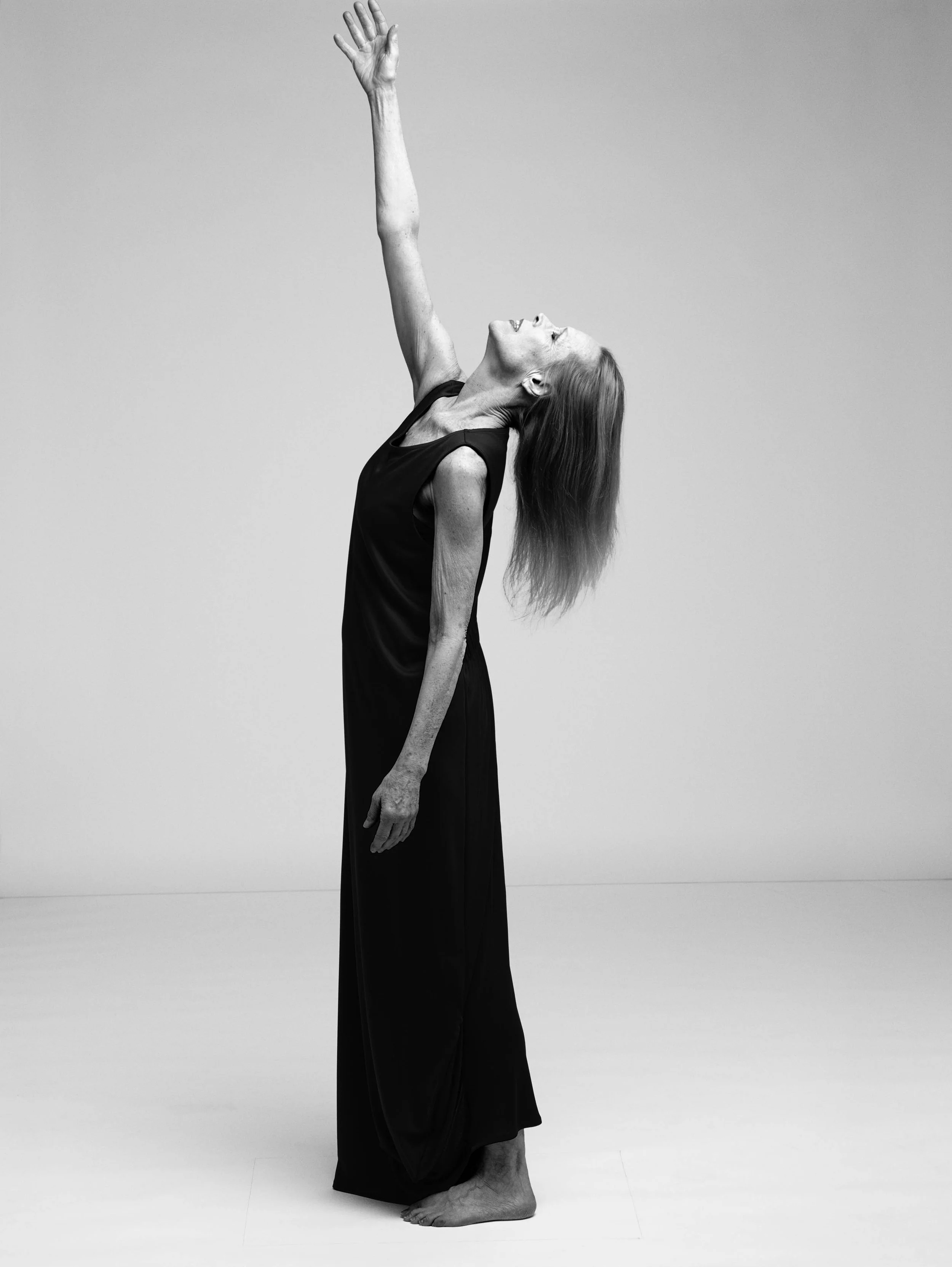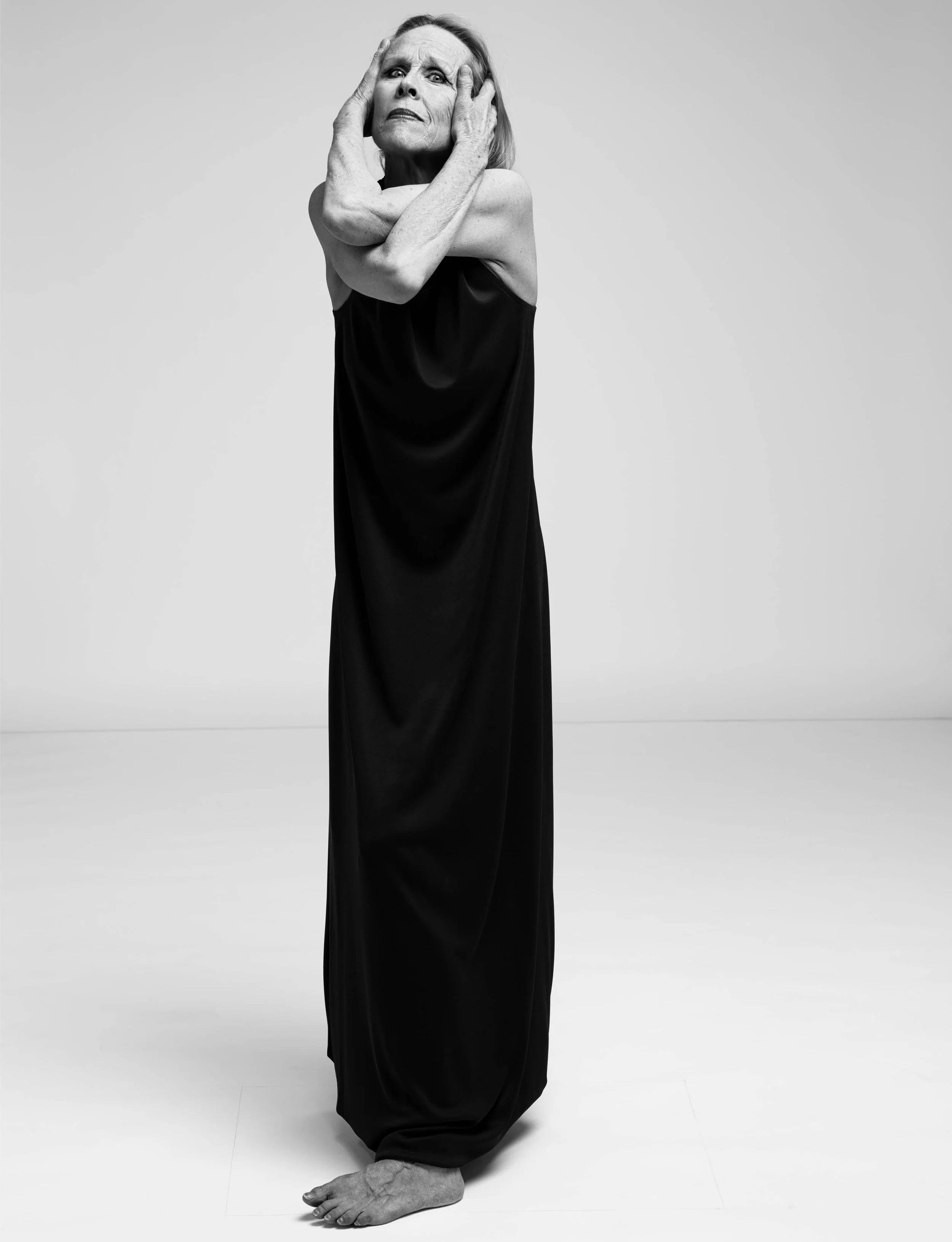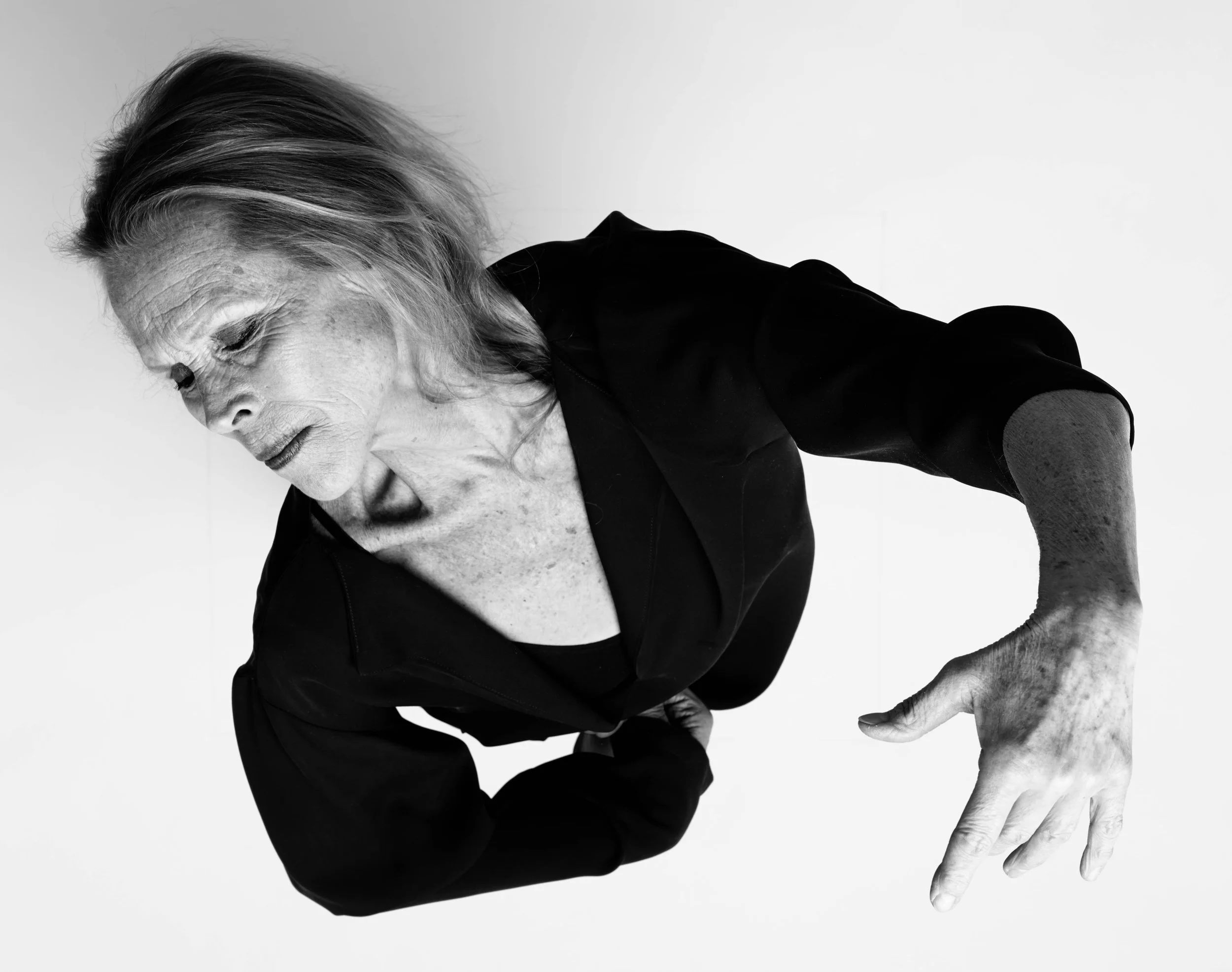ISSUE Nº21: INTERVIEW CAROLYN CARLSON
November 12, 2025
THE POETRY O F MOVEMENT: A Conversation with Carolyn Carlson
By J.L. Sirisuk
“What I talk about again i s a miracle. What is miracle? We know that breathing is a miracle. We exist because we breathe. I think we've forgotten so many things, and like you say, the mystery. Though some people try t o figure out what the mystery is, we'll never know. It's wonderful. Just go in. It lives in our spirits and our souls.”
- Carolyn Carlson
BLACK DRESS DUSAN
Carolyn Carlson moves between worlds - between poetry and movement, between the seen and the sensed. Born in San Francisco, her journey has spanned oceans and eras: from the avant-garde energy of Alwin Nikolais's New York studio to the luminous stages of the Paris Opera, where her 87-minute solo in the 1970s changed the course of European dance. For over five decades, she has been regarded not merely as a choreographer but as a visual poet, a seeker who transforms time, space, and spirit into gesture.
A pioneer of contemporary dance in Europe, Carlson has directed the Groupe de Recherches Théâtrales at the Paris Opera, led the Ballet du Nord, and founded the Atelier de Paris-Carolyn Carlson, a center for choreographic creation that continues to inspire new generations of dancers. Honored with the prestigious Golden Lion for Lifetime Achievement from the Venice Biennale, her influence extends far beyond the stage into the realms of poetry, calligraphy, and spiritual reflection. Her practice, infused with Buddhism and a lifelong reverence for nature, reveals an artist who finds eternity in impermanence: in the rhythm of waves, the breath between movements, the silence that follows. She remains a vessel for creation, for teaching, for wonder. "We've forgotten the miracle," she says. "We exist because we breathe." Through her work, whether in her iconic solo Blue Lady, her calligraphic poetry, or her mentorship at the Atelier de Paris, Carlson reminds us to look up, to see the horizon, to become once more a part of the living, breathing world.
BLACK DRESS DUSAN
J.L. Sirisuk: If I understand correctly, you're a California girl like me .
Carolyn Carlson: Yes. I was born in San Francisco, and then in the 70s they asked me to come to the Paris Opera. I did a solo dance, 87 minutes. It put me on the map, and we started a research group at the Paris Opera in the 70s. People who came had experience of improvisation, like I follow Alwin Nikolais and i t was a revolution when I think back.
JS: Before choreography, before the stage, before France, what were those first seeds o f imagination?
CC: Seeds of imagination. You know, we lived also in San Diego and by the Pacific Ocean. I was a very small child and was mesmerized by the waves, and I saw life as eternal. The waves come and they go out. They dissolve and they come back. And at that moment, my poetry started engendering as a small child.
JS: I love what you have to say about the ocean I love being my bodies of water, and maybe that's because I'm a Pisces.
CC: You are? I am too!
JS: Improvisation is a door to the soul for you what does that look like now? After so many years of dancing, has your relationship to improvisation changed?
CC: I studied with Alwin Nikolais in the 60s, and that was still the hippie generation. Everything was open and love, and we shared with other artists. From Nikolaillearned through improvisation. I knew who l was, and he always had a theme. He would go from improvisations, time, space and motion. It fascinated me because I realized each person had a gift to work on this idea, and I still work with this today. I've had my company, and I'm a choreographer. It's not far from Pina Bausch. I get an idea, improvise on the subject, and then I find the way through poetry.
BLACK DRESS DUSAN
JS: And you're a visual poet. Do you feel that that term still captures the full breadth of what you do?
CC: Absolutely. I talk about my work as visual poetry. We give the public a sense of energy, it's nothing like doing a video. I work with charismatic dancers, and I believe each person has a different soul, a different character. So we pull this out with the company, and I've been with my company now for 15 years.
JS: In terms of visual poetry and art, you also do calligraphy?
CC: When I went to New York - I was born Lutheran, but I discovered Buddhism. I found it incredible. Each moment is a life. And like the dance, it lives and dies in each moment, and through that I had lessons with a great teacher in Buddhism. We took an empty page: and this is you. We did the ink. You know, the old ink. You make your own ink. One gesture. That's it. This is you in the moment. So since that time, l've been doing my own calligraphy. Like dance, you leave a trace in the space, but you leave it on paper. I had many poetry expositions, also calligraphic with poetry.
JS: Your solo works like Blue Lady feel like dialogues with the self. Do you feel that your solos have taught you about solitude, sacredness of time?
CC: Absolutely. I have done 12 major solos in my career and Blue Ladyis one of the masterpieces. It was after my son was born and when I saw my son, I thought of the seasons of life. But when he was born, it was shocking - I know he's going to die, so I went through the seasons. I began with spring and the summer and the winter and the autumn and winter. So this was a revelation to me, and it's strange. I've always used characters in all my solos. I think I've been a very old soul, to tell you the truth. So all these characters come out.
JS: I just wanted to go back to Buddhism very quickly, which to me resonates a Buddhist, and I know that it's been a part of your daily and creative practice. Do you find that dance is meditative?
CC: Dance is a form of meditation. This is what I learned in Buddhism. You know, I used to have a master and he would go on the air and he would do the trace. And he said, "You didn't leave it in the space." And I thought, "My god, we did it again. Now, you left it in the space." So in my calligraphy and my works, you leave a trace in the space. Like Buddhism, every moment lives and dies. You do it in a moment and if you do it with the right energy, it stays in the memory of the people who see: the public. I've been accused of dream-like, slow work. It's not always slow. But the response when I came to Europe was incredible. I don't think I could have done this in New York. When I came to Europe, it's a very old country - they immediately attached to the work.
JS: Why do you think there's more appreciation and connection to your work in France rather than in New York?
CC: Even when I was working with Nikolai, I was doing my own work, but I always start from poetry. I work with the imagination, so I in a way give people back their imagination. Sometimes people say, "I don't understand everything. But I leave with something." I work with perception, not emotion, as my favorite Fernando Pessoa. Emotion is here. Perception is high. So that's what I work on, and it's very nice the comments from the audience too. They feel something, but they can't pinpoint this.
JS: It's alarming for some individuals who aren't used to just feeling, and it's really beautiful to help unveil things to people and their inner selves.
CC: I think especially how we live today. Smartphones? No. No one looks at anybody else. It's screen. You know what? Everything is visual. What happened to the telephone? I still call my friends. Now everything is visual, and that takes away a little bit from the inner. The inner eye. Inner eye to reflect. When I take the metro now, everyone is on their cell phone and they're not doing anything. They're just scrolling, but they don't know where they are in the moment.
JS: They're used to being attached to the screen - maybe scared of surprise, of what's going to happen if they look up.
CC: That's exactly what you say. They don't know where they are. Even in the metro where you're walking, they don't realize where they are. They're somewhere else. Hopefully with my poetry, I can research meditative actions.
JS: You've mentored generations of dancers throughout the years at the Atelier de Paris and beyond. What's something vital you try to pass on? Maybe not so much as technique, but as a force to your students.
CC: The force of poetry and how I speak with them. For example, your arm's not in second. You are reaching the horizon. And like vertical, you are between the heaven and earth. It totally changes people. I also studied the martial arts, and I still do chi kung, you know, the tiger and all this. The martial arts have something because they work with breath - pushing in and out, and I work very much with that in my classes. I talk about imagery in terms of filling space. You're piercing the space, the space is there, but you pierce it and you create the space.
JS: You mention moving into the horizon, into a space to feel spirit around you. I think this adds humanity to the movement.
CC: I started in ballet. It was ego. But when I was in San Francisco Ballet, I was doing the barre, and I stopped and I walked out. I said, "This isn't me." The students come away with something bigger than who they are. We're part of the universe, you know? We have trees outside. I look at the tree. You are the tree. Go to the tree and you should see the people. They go somewhere else. The most important thing we've forgotten is wonder - you look out and say, "That's just a great day. Look at the clouds." We all have. We also have to keep the child, and I keep the child inside.
JS: That sense of wonder and connectedness to what's around us, especially nature, is so important.
CC: With Buddhism, we're in the Iron Age. It's the worst age - famine, killing. But you know Alan Watts? I also follow Alan Watts. He says something beautiful. We're in the world we are in today - accept it and move on. I see what's happening in America, everywhere in the world, but I think as you said, artists have a possibility – we see the world, but we go beyond it.
JS: And you're like a vessel as an artist and a messenger.
CC: I'm still going. You know, I'm 82 and I still go. I'm doing something next year. I was born to do this.
BLACK DRESS DUSAN
BLACK DRESS DUSAN
JS: Nature seems to be a silent collaborator in your work, as in pieces like The Tree. What has nature taught you about slowness and perhaps surrender?
CC: There's books about trees who speak to each other through the roots in the ground. Trees are living and nature is living. And maybe because we grew up in America, you know, we have mountains and oceans and all this – so it depends also where you were born. I was near the Sequoia National Park and the mountains, and I went skiing in Utah where I went to school. Nature is a part of my history and especially the tree. I'm alarmed right now also about the climate change, so there's always something of nature in my pieces.
JS: The world, climate change, conflict, disconnection. In terms of artists today, what responsibility do you feel dance can hold in helping people heal right now?
CC: Great responsibility. The last work I just did, the opera dancers didn't know where I was going with it. But I said, "Just work on the poetry, please." All art has a way of healing. If you're doing hip-hop and you keep going – okay, it's spectacular. But I'm talking about Crystal Pite, she's a great choreographer. She works with poetry also. All my pieces – I have a tree or water running or something. That's so people perceive. The one thing we live with, we share together is the sun and the water, and the air we breathe. So that's a wonder also. And where does this come from? This breath. I mean, who breathes?
JS: So the mystery in our bodies, these breaths, everything - we need to be at one with it.
CC: What I talk about again is a miracle. What is miracle? We know that breathing is a miracle. We exist because we breathe. I think we've forgotten so many things, and like you say, the mystery. Though some people try to figure out what the mystery is, we'll never know. It's wonderful. Just go in. It lives in our spirits and our souls.
JS: Are you still surprised sometimes by what comes out of you when you move?
CC: I am. I do poetry concerts and sometimes I do gestures with my partner Juha, and it surprises me because I can still move. I don't do the arabesque or any of that stuff anymore, but I do poetry concerts with my friend, read the poetry, and he translates from French, and we go back and forth. It's interesting what you say, because what surprises me - I never grow old with ideas. My mind. I always have ideas, you know, and that's a gift because I go higher, like you say, in the perception. But you know what? I'm so thankful to have been born to do what I do. I'm grateful. Every day I wake up and I say, "Oh, I exist again. Wonderful."
CREDITS
PHOTOGRAPHER philippe COMETTI
CONTEMPORY DANCER | CHOREOGRAPHER carolyn CARLSON
UP NEXT





